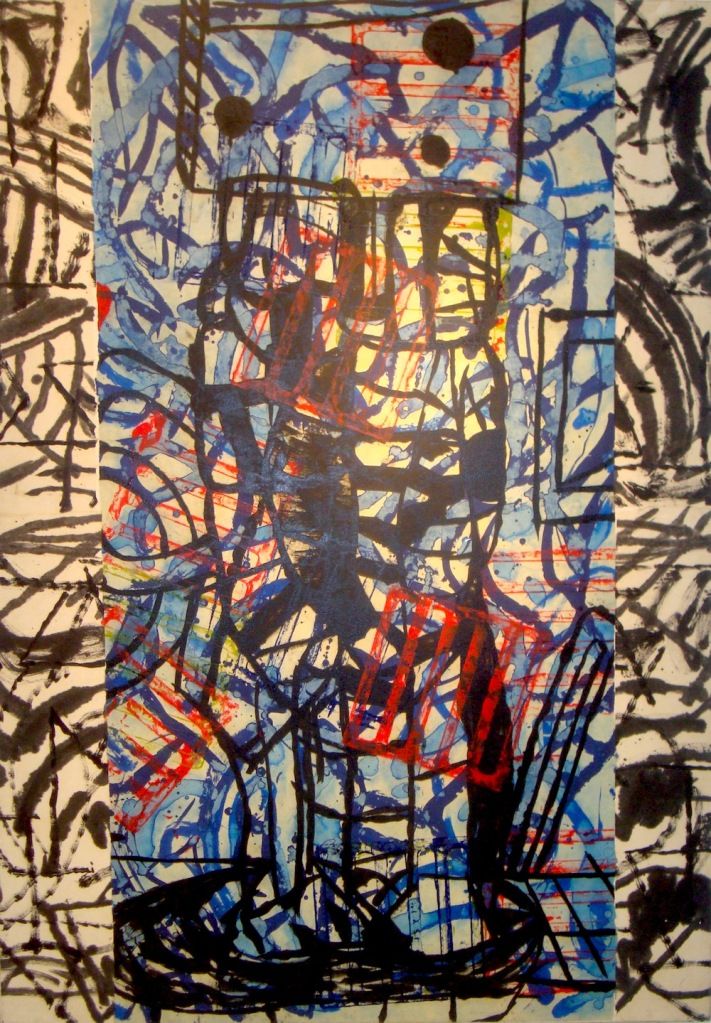When I think of Ibsen Espada's painting, I think of expressionist works collaged together out of many parts, works like Blue Kiss or the work in his most recent solo exhibit prior to this, which I wrote about last year. This work is highly linear, bordering on calligraphic, and as such belongs in the tradition of classic abstract expressionist painters like Mark Tobey, Jackson Pollock and Franz Kline. But Espada has been painting a long time (he was in the MFAH's survey of Houston painting, Fresh Paint, in 1985). His style hasn't always been the same. In his current exhibit, Ibsen Espada: 1985-2000, at the New Gallery, we see the ways in which Espada is not static. We see different techniques (with strikingly different outcomes) over time.

Ibsen Espada, Blue Kiss, 1992, 50 x 73 inches

Ibsen Espada, Hermaphrodite, 1982, 68 x 91 inches
Espada's collaging has been a part of his work for a long time, as can be seen in 1982's Hermaphrodite (a work that approaches figuration in a way they none of the other pieces do). But what this exhibit demonstrates is that at some point around 2000, Espada discovered the expressive potential of the squeegee.

Ibsen Espada, Modern Quilt 1, 2000, 60 x 72 inches
Except for Gerhard Richter, I've never heard of another artist using a squeegee to paint (and Richter uses it in a very different way). The effect is similar to using a palette knife, but a squeegee is much larger and more flexible than a palette knife. Espada used his squeegee to drag areas of pigment horizontally or vertically over the canvas. In Modern Quilt 1, the smeared paint is horizontal and highly textured. Cheery colors--pastel greens, blues, bright reds, and pale whites--dominate.

Ibsen Espada, Illyria, 2002, 51 x 72 inches
The large rectangular blue-green marks share the canvas with smaller, more streamlined purple and orange marks in Illyria. What this indicates to me is that the squeegee is a tool that the artist has some control over, like a brush or palette knife. The rough blue-green streaks come from the right and left edges of the canvas, trying to reach the center. They have narrow violet marks on them. And beneath them the droplet shaped orange and purple marks, which are in turn superimposed over a layer of sky--pale blue and white.

Ibsen Espada, Swimming Up Stream, 2002, 33 x 95 inches
The streamlined marks may remind on of raindrops in flight or of fish. The title Swimming Up Stream seems therefore particularly apt, with its vertical arrangement of shapes clustered like a school of fish. Espade layers them from dark (aquamarine blue) at bottom, followed by pale green, pink, magenta and white on top. The colors are transparent to an extent. Each layer is a reaction to--or perhaps a dialogue with--the layers below it.

Ibsen Espada, Torpedo Web, 2002, 33 x 96 inches
Of course, this streamline shape could have a sinister interpretation. Torpedos, missiles, bombs dropped from planes--all have versions of this aerodynamic shape. Torpedo Web expresses this. Its grimly monochromatic palette reminds me a bit of the colors of camouflage, which is reinforced by the lines of the "web."
I don't know if Espada uses the squeegee technique any longer. It wasn't evident in his last exhibit. Maybe this is a technique that he feels he has thoroughly explored and no longer needs. Whatever the case, he completed a number of very interesting, visually engaging paintings employing this unusual artistic tool, and they are worth seeking out.




Aside from Richter using a squeegee, both David Diao and Jack Whitten made paintings in NYC in the late '60s and '70s by making their own, often huge painting implements, including squeegees. They look different from Richter too (although Whitten can look very similar, and that would probably be more properly described as Richter looking close to Whitten). There's a bit of info on this in the exhibition catalog to the WMAA show "High Times, Hard Times" (Painting in from '60-something to '70 something).
ReplyDeleteI figured that there were probably more squeegee painters. After all, it seems like a logical painting tool--especially if you've ever witnessed someone doing silkscreens.
ReplyDeleteAlso, a big difference between Espada and Richter is that Espada used a small squeegee instead of a painting-sized one like Richter uses.
Thanks for this 40 year exploration of Ibsen's work. I very much like the squeegee paintings having devoted much time to this in the late 1970's. The first paintings David Gray saw of mine, about 1980, were on a visit with Earl to my studio. And I still glaze in a squeegee manner.
ReplyDeleteIbsen's work has always seemed a very personal identification; to me, it is more of a Hans Hoffman push-pull. Yet we own an Espada that is more figurative.
We have seen quite a few young artists employing this dragging of pigments-on-a-stick. Also,Vincent Falsetta has been dragging pigments for a long,long time. It's still a brush but it is in the tradition of Richter, placing a chosen palette on a straight-edge and then drag.
Large palette-knives also work like a squeegee. Scale certainly dictates implement size.
Thank you NEw GALLERY for a great retrospective of Sr.Ibsen Espada. Spanning four decades, I am reminded of his integral part in my Houston Art experience. What I saw was vintage Espada. His study with Dirube in Puerto Rico. Mixing the paints. His gallery/studio home on Morrison St. in the 80's and 90's. I saw Ibsen as the Mick Jagger of the Houston Art scene. Passion. Conviction. Love. Of Life and of Art. Ibsen's influence upon a whole generation of Intergalactic Artists 4 Peace in Houston and the world make him such a loved and integral part of our Houston art heritage.
ReplyDelete